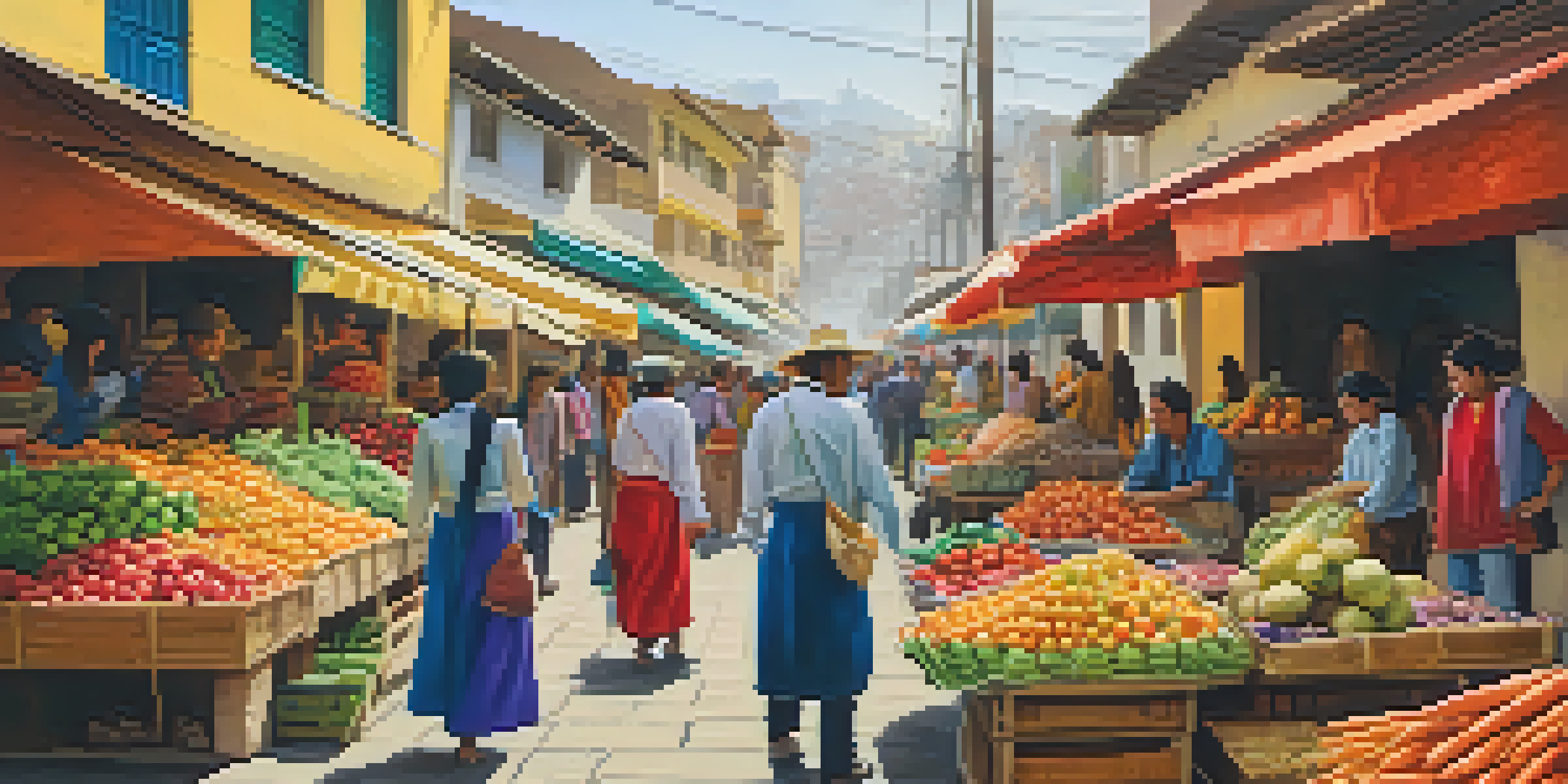Understanding Peruvian Dialects: A Guide for Travelers

Introduction to the Rich Tapestry of Peruvian Dialects
Peru is a country rich in culture and diversity, which is beautifully reflected in its languages and dialects. While Spanish is the official language, various indigenous languages and regional dialects bring a unique flavor to the communication landscape. For travelers, understanding these dialects can enhance your experience and help you connect with locals on a deeper level.
Language is the road map of a culture. It tells you where its people come from and where they are going.
In this guide, we'll explore some of the key dialects you'll encounter in Peru, including their origins and how they differ from standard Spanish. This knowledge will not only enrich your travels but also show respect for the cultural heritage of the people you meet. So, whether you're wandering through Lima or hiking the Inca Trail, knowing a bit about the linguistic landscape will serve you well.
As you prepare for your trip, remember that language is a bridge to understanding and appreciation. Embracing the diversity of Peruvian dialects will make your journey more memorable, allowing for authentic interactions that go beyond the surface.
Spanish Variations in Peru: Not Just One Way to Speak
In Peru, the Spanish language is spoken with distinct regional variations. The accent and vocabulary can differ significantly between the coastal areas, the highlands, and the jungle regions. For example, coastal Peruvians often drop the 's' sound, making their speech sound more relaxed and fluid, whereas people in the Andes may use a more traditional pronunciation.

Additionally, certain words can take on different meanings in various regions. For instance, the word 'jato' refers to 'house' in Lima, but in other areas, it might not be understood at all. This playful twist in language can lead to charming interactions or amusing misunderstandings, underscoring the importance of being aware of regional dialects.
Peru's Language Diversity
Peru's rich cultural heritage is reflected in its diverse dialects and indigenous languages, enhancing traveler experiences.
Travelers should keep an open mind and be willing to adapt to these linguistic quirks. Engaging with locals in their dialect can foster a sense of camaraderie and make your travel experience much richer.
Indigenous Languages: A Testament to Peru's Heritage
Peru is home to a variety of indigenous languages, the most prominent being Quechua and Aymara. These languages are not just remnants of the past; they are vibrant forms of communication that are actively spoken by millions of Peruvians today. Learning a few phrases in these languages can endear you to locals and show your appreciation for their culture.
To learn a language is to have one more window from which to look at the world.
Quechua, for instance, is often spoken in the Andean regions and is known for its unique structure and vocabulary. Aymara, on the other hand, is primarily found in the southern highlands and around Lake Titicaca. Both languages are rich in history and meaning, and they offer a fascinating glimpse into the worldview of their speakers.
As a traveler, taking the time to learn greetings or basic phrases in these languages can create wonderful connections. It demonstrates respect and curiosity, often leading to warm smiles and enthusiastic responses from locals eager to share their culture.
Regional Slang: Getting to Know the Local Lingo
Every region in Peru has its own slang that reflects local culture and humor. Understanding these colloquial terms can make conversations with locals more enjoyable and engaging. For example, if someone calls you 'pata,' it means 'friend' in Lima, while 'broder' might be used in other areas to convey a similar sentiment.
In addition to friendly greetings, slang can also reveal the playful nature of Peruvian communication. Locals often use humor and creativity in their language, so don't be surprised if you hear unexpected phrases or metaphors. This vibrant use of language adds color to your travel experience.
Regional Dialects Matter
Understanding regional slang and variations in Spanish can foster deeper connections with locals and enrich your travels.
To navigate these slang terms successfully, consider asking locals about their favorite expressions. Engaging in this way not only enhances your understanding but also shows your interest in their way of life, opening the door to deeper conversations.
Common Expressions: Enhancing Everyday Conversations
Familiarizing yourself with common expressions can greatly improve your interactions in Peru. Phrases like '¿Qué tal?' (How’s it going?) and '¡Claro!' (Of course!) are essential for everyday conversations and can make you sound more like a local. These simple expressions help to break the ice and create a friendly atmosphere.
Moreover, using polite phrases like 'por favor' (please) and 'gracias' (thank you) goes a long way in showing respect and gratitude. Peruvians are known for their hospitality, and a little effort in using their language can lead to warmer interactions and even friendships.
As you travel, don't hesitate to practice these expressions with locals. Most people appreciate when visitors try to speak their language, and you might be pleasantly surprised by how this can enhance your travel experience.
Navigating Language Barriers: Tips for Travelers
Language barriers can be a challenge, but they can also lead to memorable experiences. When faced with difficulty in communication, try to remain patient and use gestures or visual aids to convey your message. Many Peruvians are understanding and will appreciate your efforts to communicate, regardless of the language you use.
Using translation apps on your smartphone can also be a lifesaver. These tools can help bridge the gap between dialects and languages, allowing you to converse more easily. Just remember to download the necessary resources before your trip, as internet access can be limited in remote areas.
Embrace Local Expressions
Learning common phrases and expressions can significantly improve interactions and demonstrate respect for Peruvian culture.
Lastly, consider traveling with a local guide who can help navigate linguistic nuances. A knowledgeable guide can provide insights into not only language but also local customs and traditions, enriching your travel experience even further.
Conclusion: Embrace the Linguistic Adventure in Peru
Understanding Peruvian dialects and languages is more than just a travel tip; it's an invitation to immerse yourself in the vibrant culture of the country. Each dialect and language offers a unique perspective on the rich tapestry of Peruvian life. By embracing these linguistic nuances, you'll enhance your interactions and create lasting memories.
So, as you plan your trip to Peru, remember to take the time to learn a few words and phrases. Your willingness to engage with the local language will not only open doors but also foster connections that transcend the barriers of speech.

Ultimately, language is a powerful tool for connection, and in Peru, it serves as a gateway to friendship and understanding. So pack your bags, brush up on your phrases, and get ready for a linguistic adventure!